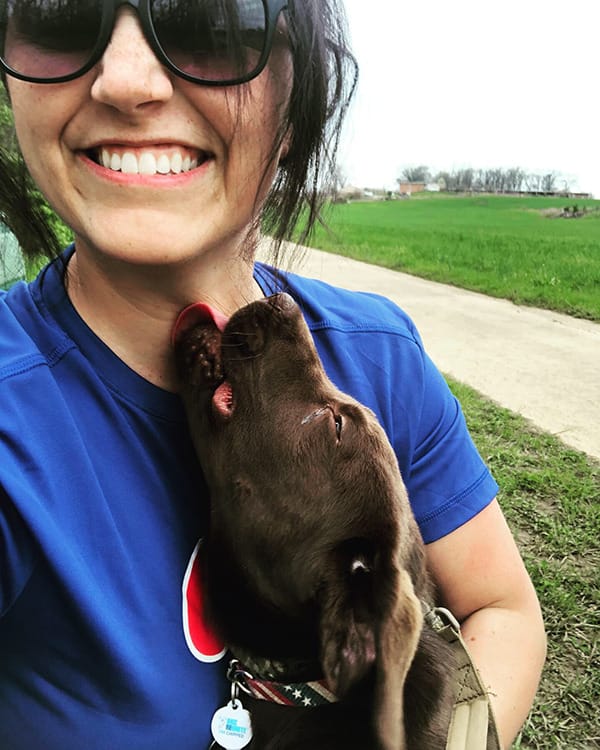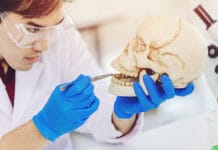Article co-written by Kayla Wells, RDH, BS, and Lauren Owen, BSDH, RDH.
You arrive home from a long day at the office, and all you want to do is lie down for a moment and relax those muscles you have exerted all day. Your sweet pup comes up and licks your hand or licks your cheek because he or she has missed you! You have been gone all day, and that is a century to a dog. You do not think about it, but you get up and prepare dinner. Your husband/wife kisses that same cheek, or your kids kiss that same cheek. You are human, so you forget to wash your hands that your dog kissed.
Bacteria just crossed over from pet to human.
Oral hygiene instructions are a component of every dental appointment for humans. However, not much is being said about the relationship between human oral health and their pet’s oral health. Most pet owners are unaware that they can contract the bacteria that causes periodontal disease from their “fur babies.”
Perio in Pets
Dental professionals are aware of what periodontitis is. However, readers outside the dental world may not understand. Periodontitis is an infection that damages the gingiva and, without treatment, can cause bone loss around teeth, which may lead to tooth loss. Gingiva begins to hurt, bleeding occurs, appetite changes may occur due to pain, and mobility in tooth/teeth occurs.
Periodontal disease is reported to be the most common disease affecting dogs and cats worldwide.2 Statistically speaking, 63% of pet owners have never had their pets’ teeth cleaned.2 Preventive dental care (prophylaxis, scaling) improves the well-being of the pets and their owners.3 Just as in humans, regular biofilm and calculus control and professional cleanings are beneficial.2
Unfortunately, 50% to 70% of dogs have periodontal disease.3 Periodontal disease in pets is comparable to humans. Similarities include increases with age, and just like ethnicities, certain breeds are at a much higher risk.3
The dog breeds at the highest risk are:2
- Toy Poodle
- Yorkshire Terrier
- Maltese
- Pomeranian
- Shetland Sheepdog
- Cavalier King Charles Spaniel
- Papillion
- Standard Poodle
- Dachshund
- Havanese
- 11.Bichon Frise
- Beagle
- West Highland White Terrier
- Collie
- Miniature Schnauzer
- American Cocker Spaniel
- Basset Hound
- Cockapoo
- Chihuahua
- Welsh Corgi
- Rat Terrier
- Lhasa Apso
- Fox Terrier
- Jack Russell Terrier
- Miniature Pinscher
- Pekingese
- Shih Tzu
- American Eskimo
Bacterial Transmission
You may be wondering: What periodontal bacteria in dogs are found in the human oral cavity? A study by Yamasaki, Nomura, Nakano, Naka, Matsumoto-Nakano, Asai, Ooshima (2011), the comparison of periodontal pathogens was examined. “The purpose of this study was to determine if periodontopathic bacterial species could be transmitted to owner from dog. The examiners obtained specimens of dental plaque from 64 families, with 81 people from those families and 66 dogs. These subjects all came to either an animal clinic or dog training school in Japan. They inoculated each specimen with different primers that were specific to 11 different periodontic pathogens.”3
The results indicated that close contact could contribute to the transmission, but it is not the only factor. Transmission is possible through any kind of contact, increasing with the number of dogs per household. The examiners also detected a significant correlation between P. gulae (previously classified as P. gingivalis), E. corrodens, T. forsythia, and T. denticola in the dog specimens and the presence of them in the owners who had close contact with the dogs. These results showed that even though periodontic pathogens are different in humans and dogs, transmission between the two can still occur.3
Similar to human transmission, periodontal disease can be transmitted from dog to dog.3 This makes households with multiple dogs more susceptible, especially when they share the same bowl.3 As previously stated, bacteria can be transmitted from dogs to humans.3 If there is salivary contact on or around the oral cavity, this leads to a higher risk of transmitting bacteria from the dog to the owner. Bacteria from the dog’s oral cavity to the owner can be transmitted daily through close contact.

Preventive Steps
What preventive measures can pet owners take to lower this transmission? Regular dental care for dogs and owners. Veterinarian-recommended oral treats are a good option for daily plaque removal.4 A more “natural” diet is beneficial due to the abrasives (raw bones or prey analogues).3
“Dental chews such as cartilaginous materials, rawhide, or specially formulated hygiene chews, some of which meet VOHC [Veterinary Oral Health Council] standards, provide a mechanical or enzyme” cleaning action and can be an effective adjunct to a dental health regimen. Similarly, dental chew toys can provide chewing exercise and some tooth cleaning action without trauma to the teeth.”3
Do you practice what you preach at work? In my opinion, another no-brainer for dental professional pet owners is to simply brush their dog’s teeth. Educating our patients in the dental office is a key factor during their appointment. When we care for our pets, we have to be their advocates. A hydrated mouth keeps plaque from accumulating fast. Using a toothbrush, gauze, dentifrices (pastes, liquids, powders) are important.3
Also, as much as we love to snuggle up and accept kisses from our furry companion, keeping the distance between you and your pet is safe. Maintaining basic hygiene habits when handling pets is important. Wash your hands, face, or neck after your pet kisses you. Try to avoid kisses on the lips. We are human, and we will forget at times, but keep in mind the risk is there.
What are other approaches to prevention? Good news! Vaccines have been tested and made for the periodontal pathogen Poryphymonas gulae.2 Studies involved mice in fabricating the first periodontal vaccine for dogs. The studies showed that the inactive P. gulae vaccine inhibits the progression of alveolar bone loss. Inactivated P. gulae were shown to have varying degrees of efficacy with different animal models.5 One was granted conditional licensure by the USDA. Unfortunately, this study was later discontinued because of inconsistency.5 More research is being done to create a more consistent form of the previous vaccine.
So, take a moment and soak all this information in. Are veterinarians and dentists aware of this correlation and the possibility of a vaccine? This is a viable knowledge that is needed if the prevention of the transmission of periodontal disease between pets and owners is going to happen.
What Vets Think?
As previously mentioned, knowledge of a possible bacteria transmission from pets to owners is a new topic on the rise. An idea and model have also been formulated for a periodontal pathogen vaccine.5 With this new knowledge, it has been shown that these transmissions can have a negative effect on public health. With the combination of more individuals having pets and the lack of knowledge, these complications can lead to increased occurrences between individuals, leading to more severe periodontal cases within the public.
We decided to dig into this new information and came up with a questionnaire for veterinarians. The questionnaire was hand-delivered to approximately 15 local veterinarians in southern Kentucky and middle Tennessee area. These questions helped us gather information on how and if pet owners are educated on the possibility of periodontal pathogen transmission and prevention methods.
We also analyzed the willingness of veterinarians to invest in a vaccine if one were to become available in the market. At the beginning of the questionnaire, each veterinarian was to disclose his or her demographics, including the area of practice and years of practice.
In summary, the methodology involved in this study included an analysis of veterinarians’ information they disclosed on a questionnaire. The questionnaire was focused on education and willingness to support a vaccine. Do veterinarians feel that this transmission is a significant issue, and would they take steps to improve this dilemma? The questions focused on the practitioners’ knowledge, the habits of educating their patients, and the willingness to purchase a vaccine.
Before dividing the data by experience, we analyzed the overall results from the 10 participants. The results showed that 40% of the respondents were aware that pet owners could contract periodontal disease from his or her pet. Everyone in this group had practiced for less than 40 years. My colleague and I believe that they knew about this possible transmission because they were in school or freshly out of school around the time the first periodontal pathogen vaccine was being fabricated but later failed.
Even though we found that 40% are aware of the possible transmission, the responses revealed that 70% do not educate all patients on this possibility. All of the respondents who stated that the transmission is an issue also indicated that they would invest in the vaccine if one were to be available. When habits of education were analyzed, we found that 30% of respondents who educate the pet owners all have less than 25 years of experience.
The results show that the cost of the vaccine is not the primary issue. The issue is with awareness and education. All who are aware of this transmission being an issue are willing to invest in a vaccine.
The community needs to be more aware and place more emphasis on education. While analyzing years of practice compared to habits of education, we concluded that the longer the practitioner has been in practice, the less likely it is they are to educate the pet owners on the possibility of transmission of periodontal pathogens. We concluded this because when the individual practitioners, who have practiced over 25 years, were in veterinarian school, the emphasis was not on the education of pet owners about periodontal disease until more modern thinking was obtained. Last, it appeared that the location of the veterinary school was not a factor in the responses. Further study is necessary.
In conclusion, periodontal disease affects a large percentage of canines. Dental professionals understand how health starts in the oral cavity and how oral health affects systemic health. In dogs, the risk is still there. Periodontal disease increases the risk of developing kidney, lung, heart diseases. We need to be the advocate for our pets, especially if we want to increase their livelihood. There needs to be a push to develop a reliable vaccine. If we can already treat antibodies against certain bacterial pathogens via vaccines, why can we not do the same in regard to P. Gulae?
Now Listen to the Today’s RDH Dental Hygiene Podcast Below:
References
- Weinberg, M.A., Westphal, C., Froum, S.T, Palat, J.D., Schoor, R., Comprehensive Periodontics for the Dental Hygienist. Upper Saddle River, New Jersey. Pearson Education; 2010. (pp. 521).
- Shearer, P., Periodontal Literature Review. BARK. 2010 Feb; 1-8. Retrieved from https://www.banfield.com/getmedia/fca67363-7362-4bb0-9824-50905f7ca817/48fdbdb1-8ff0-40b6-8d7f-3e8fac47de3a-pdf0
- Yamasaki, Y., Nomura, R., Nakano, K., et al. Distribution of Periodontopathic Bacterial Species in Dogs and Their Owners. Archives of Oral Biology. 2012 Feb 13; 57(9): 1183-1188.
- Foster, R., Smith, M. (n.d.). Dental Care: What to Include in a Complete Program. Retrieved from http://www.peteducation.com/article.cfm?c=2+2089&aid=517
- Hardman, J., Reed, M., Wong, J., et al. Evaluation of a Monovalent Companion Animal Periodontal Disease Vaccine in an Experimental Mouse Periodontitis Model. Vaccine. 2004 Sep 2; 23(2005): 3148-3156.












